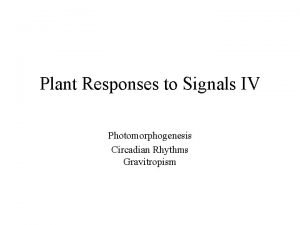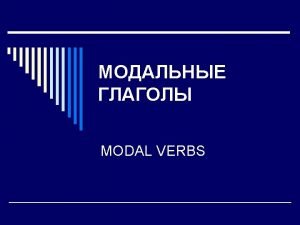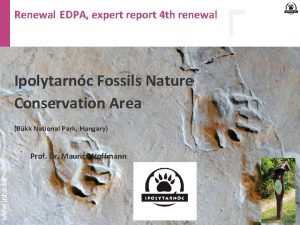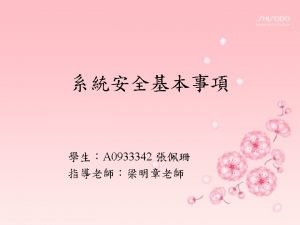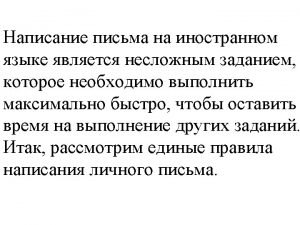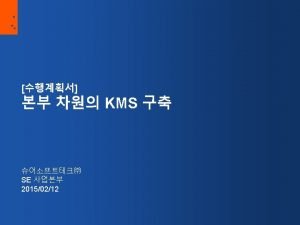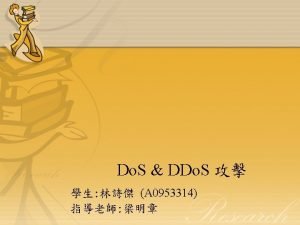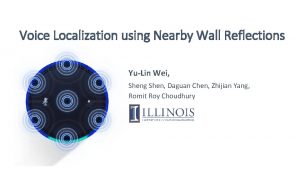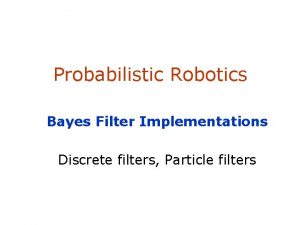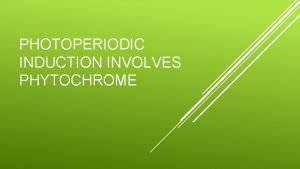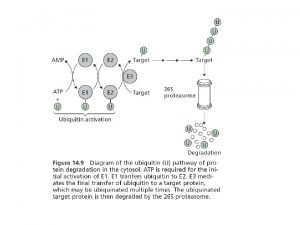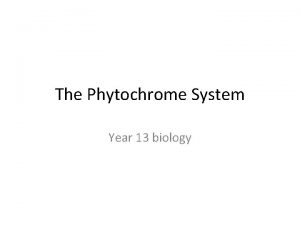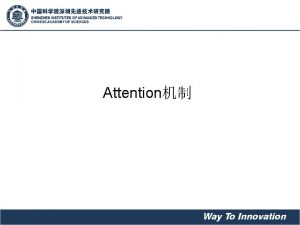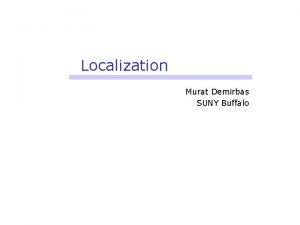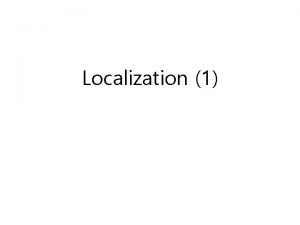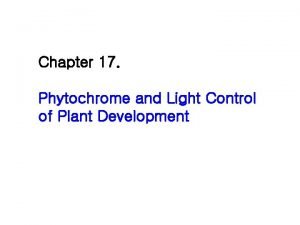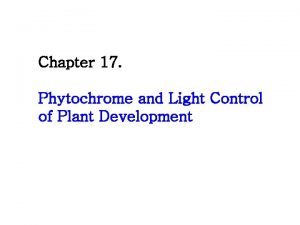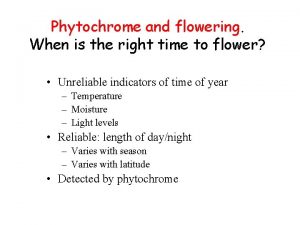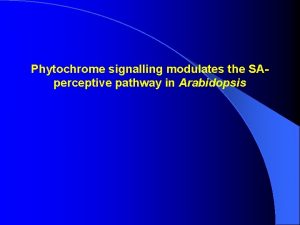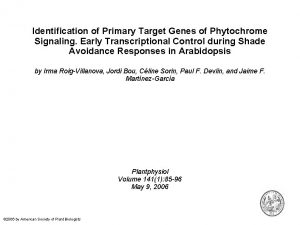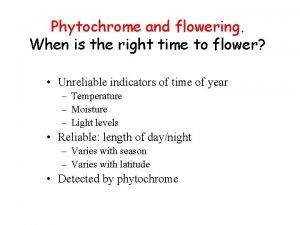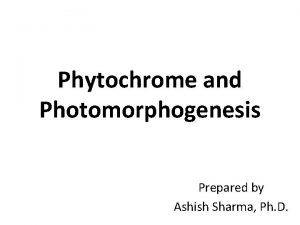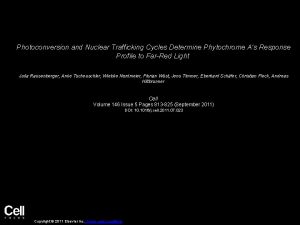Thanks for your attention Localization of Phytochrome in























- Slides: 23

Thanks for your attention

Localization of Phytochrome in tissues and cells

Phytochrome can be detected in tisuses spectrophotometrically In green tissue, it is difficult to detect phytochrome because its color is masked by chlorophyll In dark grown plants, phytochrome has been detected. Etiolated seedling the highest phytochrome levels are usually found in meristemic regions or vicinity. (Fig. 17. 6)

Phytochrome is differentially expressed in different tissues Type 1 Phy: Phy. A In dark grown seedling, highest amount in apical hook and root tips In light grown seedling, same pattern but less expression (may be degraded) Type II: Phy. B, Phy. C, Phy. D, Phy. E Less active than the Type 1, different pattern from Type 1

Characteristics of phytochrome induced whole-cell responses

Charateristics of Phytochrome-induced responses 1. Rapid biochemical events 2. Slower morphological changes

Phytochrome Responses Vary in Lag Time and Escape Time Morphological response to the photoactivation of phytochrome may be observed after lag time (the time between stimulation and an observed response, a few minute to several weeks). Rapid responses: 1) movement of organelles, 2) volume changes, 3) some growth responses Developmental changes by light 1. A decrease in the rate of stem elongation 2. The beginning of apical-hook straightening 3. The initiation of the synthesis of pigments

Major step of lag time • < 8 min, red-light inhibition of stem elongation rate • 3 hrs, Phy. A was disappeared and Phy. B contributes • Several weeks, induction of flowering

Escape from photoreversibility A Model to explain: Phytochrome controlled morphological responses are the results of a step-by-stepsequence of linked biochemical reactions in the responding cells. each of these sequences has a point of no return

Phytochrome Responses Can Be Distinguished by the Amount of Light Required - Fluence : the amount of light - Units for fluence : moles of quanta per square meter (mol m-2) - Irradiance: fluence rate of light - Units of irradiance : moles of quanta per square meter per second (mol m-2 s-1)

Three major categories of phytochome responses based on the amount of light required 1. Very low fluence responses (VLFRs) 2. Low fluence responses (LFRs) 3. High irradiance responses (HIRs)

Three types of phytochrome responses

Very Low Fluence Responses Are Nonphotoreversible VLFRs - initiated by fluences as low as 1. 0 nmol m-2 - saturate at about 50 nmol m-2. example 1) In dark-grown oat seedling, stimulate the growth of coleoptile and inhibit the growth of the mesocotyl example 2) Arabidopsis can be induced to germinate with red light Far red light can not reverse VLFRs * The minite amount of light needed to induce VLFRs convert * After far-red, 3% of the Phy remains as Pfr form

Low-Fluence Responses Are Phoporeversible LFRs… -cannot be initiated until the fluence reaches 1, 0 μmol m-2 - saturated at 1000μmol m-2. -include most of the red/far-red photoreversible reponses. Table 17 -1. Typical photoreversible responses

LFR action spectra 660 nm 720 nm

Law Of Reciprocity Recoprocal relationship between fluence rate and time VLFRs and LFRs obey this law Total fluence is a function of two factors: fluence rate and irradiation time - a brief pulse of red light if the light is sufficient bright - very dim light if the irradiation time is long enough)

High-irradiance Responses Are Proportional To The Irradiation and The Duration HIRs… - require prolonged or continuous exposure to light of relatively high irradiance - is proportional to the irradiation within certain range - saturate at much higher fluences than LFRs - at high irradiance light, the effect is not reversible with farred light (at low fluences, the effect is reversible with far-red light)

Lists of Some HIRs

The HIR Action Spectrum Of Etiolated Seedlings Has Peaks In the Far-red, Blue, And UV-A Regions

Inhibition of hypocotyl elongation in etiolated seedling WT seedling: exhibited peaks in the UV-A, blue, far-red regions of the spectrum hy 2 seedling: exhibited peaks in the UV-A, blue regions of the spectrum not responsive to either far-red or red light

The HIR Action Specrtum Of Green Plants Has A Major Red Peak Result The action spectrum for the inhibition of hypocotyl growth of light-grown green seedling show a single major peak in the red.

Meaning 1. The loss of responsiveness to continuous far-red light is strongly correlated with the depletion of the light-labile pool of Type I phytochrome (Phy. A) 2. The HIR of etiolated seedling to far-red light is mediated by Phy. A, whereas the HIR of green seedling to red light is mediated by the Type II Phytochrome

Thanks for your attention
 Phytochrome function
Phytochrome function Gustation and olfaction
Gustation and olfaction Blie danube
Blie danube Thanks for your attencion
Thanks for your attencion Thanks for your attention
Thanks for your attention Ifnca
Ifnca Thanks for your attention
Thanks for your attention Gartner erp matrix
Gartner erp matrix Alternating attention vs divided attention
Alternating attention vs divided attention Thanks you for your listening
Thanks you for your listening Thanks a lot for your letter
Thanks a lot for your letter Dear ben thank you for your letter
Dear ben thank you for your letter Thank you for your kind attention.
Thank you for your kind attention. Thanks for your audience
Thanks for your audience Thanks for your listening
Thanks for your listening Complete the letter. write one word for each space
Complete the letter. write one word for each space English module grade 10
English module grade 10 Voice localization using nearby wall reflections
Voice localization using nearby wall reflections Localization of function ib psychology
Localization of function ib psychology Localisation of distributed data
Localisation of distributed data Query decomposition in dbms
Query decomposition in dbms Discrete bayes filter
Discrete bayes filter Localization of behavior
Localization of behavior Buccal object rule
Buccal object rule
